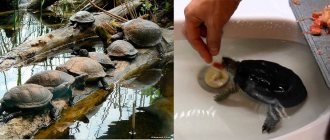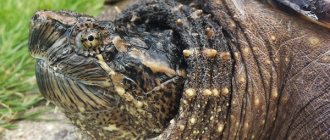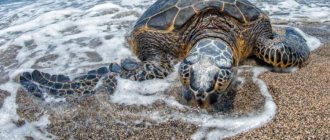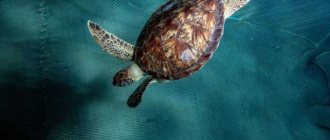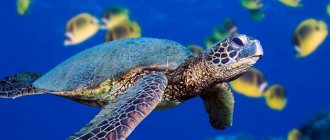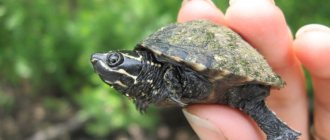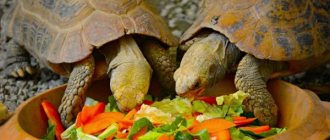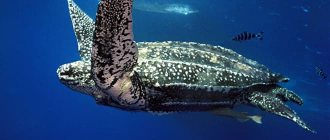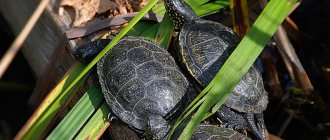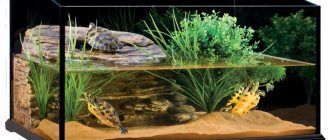The largest turtle in the world is the leatherback turtle. But she is a resident of the water element, but on land the elephant turtle holds the palm among the group. This animal belongs to the class of reptiles. The Galapagos elephant tortoise is a representative of the family of land tortoises, which includes the genus of American tortoises, to which the heroine of our “story” belongs.
The Galapagos elephant tortoise is one of the rarest species on planet Earth. Climate change and human influence on nature have made these animals an endangered species.
How to recognize a Galapagos elephant tortoise by its external features?
This giant turtle weighs about 300 kilograms. The diameter of its shell is almost one and a half meters, and this animal grows up to one meter in height! It is difficult not to notice such a turtle, although it is slightly smaller than the leatherback one.
A distinctive feature of the elephant turtle is its long neck, and it also has rather long legs, thanks to which it lifts its body high from the ground. The shell of this representative of the turtle “kingdom” is painted black.
Why did the turtle get the name “elephant”? It's all about its appearance: not only does it have an impressive “elephant” size, the similarity with these animals is also indicated by the turtle’s legs: they are so massive that they really look like the legs of an elephant. The similarity is also evident in the large number of skin folds on the neck.
The shell of an elephant tortoise is somewhat reminiscent of a saddle: it is slightly raised in front, and has a slope and a small notch in the back.
Elephant turtles grazing peacefully
Description
The body of the animal is covered with a thick bony shell, which is light brown in color. Thick plates are connected to the animal's ribs and provide protection for the body . In some cases, lichens may grow on turtle shells. Upon careful examination of the design on the plates, you will find that it is unique. With age, the plates wear out, but do not disappear completely.
If the Galapagos tortoise senses danger, it takes certain measures for its safety. She retracts her head, neck and front legs into her shell, this protects her from damage.
The feet of the elephant tortoise are large and strong; there are five claws on the front ones, and four on the back ones, which are much larger in size. The hind limbs of the animal are much stronger than the front ones and it prefers to defend itself with them if necessary.
- Animals of Siberia
- 35 facts about giraffes
- Animals of Crimea
- 36 facts about elephants
- Rodents
- 35 facts about foxes
There are several subspecies of the elephant turtle, identified by scientists.
Classification:
- Elephant Rothschild;
- Darwin's Elephant;
- Hispaniola;
- Isabel elephant and others.
Appearance
One of the two largest species of land turtles: the length of its carapace can reach 122 cm with a body weight of up to 300 kg.
There is significant variation in shell size and shape among different elephant tortoise populations. Based on this feature, they can be divided into two main groups:
- On small arid islands, turtles are small, with saddle-shaped shells. Their legs are longer and thinner. The weight of females is up to 27 kg, males up to 54 kg.
- On large, wet islands, turtles are larger and their shells are tall and dome-shaped. The difference in size between males and females is not so pronounced.
Elephant tortoise habitat It is believed that the saddle-shaped shell allows turtles to penetrate dense vegetation and take refuge there.
The reptile is endemic to the Galapagos Islands, which are located 1 thousand km from Ecuador. Previously, according to scientists, it inhabited South America, from where it came to its current location by swimming, using the passing Peruvian Current.
The habitat of different subspecies of turtles is different - they inhabit wet highlands or dry lowlands. On seven isolated islands, separate ecosystems have formed with a warm climate favorable for reptiles and an abundance of plant food. In species that settled on wet islands, the shape of the shell is dome-shaped. The inhabitants of dry areas acquired saddle-shaped shells of more modest sizes.
Lifestyle of Elephant Turtles
These representatives of the land turtle family live in rather difficult conditions. Where they live, there is always a very high temperature, hot climate and sparse vegetation. Therefore, they have to be unpretentious when it comes to food. In their areas of residence, they try to stay close to broad-leaved tropical forests, on plains covered with bushes, or in savannas. In the Galapagos Islands, elephant tortoises live in the lowlands.
Young individuals have a lighter shade of carapace.
During daylight hours, these animals show increased caution, but with the onset of night they seem to turn into blind and deaf creatures - they move around, not paying attention to what is happening around them and lose their vigilance. By the way, elephant turtles are very slow creatures! In a whole day they can walk no more than 6 kilometers.
Interesting Facts
- The residents of the Cairo Zoo, a tortoise named Samira and her husband, were considered the longest-lived among the Galapagos tortoises. The female died at the age of 315, and the male was only a few years shy of his 400th birthday.
- After sailors discovered the Galapagos Islands in the 17th century, they began to use local turtles for food. Since these majestic animals can go without food or water for several months, sailors simply lowered them into the holds of their ships and ate them as needed. In just two centuries, 10 million turtles were thus destroyed.
What does the Galapagos tortoise eat?
The elephant tortoise eats vegetation. She eats literally any greenery: be it leaves of bushes or succulent cacti, grass or young shoots. In addition, it can feed on woody lichens and the fruits of fruit and berry plants. The turtle eats algae and other aquatic plants. But the most important delicacy for her was and remains... tomatoes!
Galapagos tortoises are absolutely safe for people, who, however, took advantage of this, which almost led to the extinction of these tortoises.
The turtle rarely drinks water because it has the ability to store it in its body for a large amount of time.
Why is it listed in the Red Book?
In the 19th century Elephant turtles were found on Pinta Island. The main reason for the disappearance of the turtle subspecies was that almost all the vegetation on the island was exterminated by feral goats. As a result, the turtles had no food resources left. The clumsy and slow-moving reptiles were easy prey for poachers by the early 1970s. XX century Only one representative of the subspecies managed to survive.
The last representative of the rare taxon was named Lonesome George. Lonesome George was discovered on Pinta Island (Abingdon). December 1, 1972 and was taken under observation. The last years of his life he lived in the Galapagos National Park of Ecuador, at the station named after. Charles Darwin on St. Croix. Here they looked after him and hoped to get viable offspring from him. Until recently, scientists hoped to restore the subspecies and return it to its natural habitat.
Reproduction of elephant turtles
Every year, from April to November, females lay their eggs. This happens in the same place, which is specially prepared in advance by caring parents. One clutch contains from 2 to 20 eggs. Six months later, a new generation of land giants is born from the laid eggs in the “nest”.
A baby elephant turtle just hatched from an egg.
Elephant turtles are known to be long-lived animals. Cases have been recorded when they lived to be 100, or even 150, years old!
Nutrition
These reptiles are herbivores. They eat cacti, grass, leaves, lichens, berries, and fruits. Young Galapagos tortoises eat 17% of their body weight per day. They mainly obtain moisture from dew and vegetation. They can survive without water for 6 months. They can live without food for up to a year, consuming their fat reserves.
Elephant turtles maintain relationships with birds, which peck ectoparasites from their bodies. A group of finches surrounds the turtle, and it straightens its legs, stretches its neck, giving the small birds the opportunity to get to the most inconvenient places on its body. But sometimes the turtle shows amazing cunning towards the pichus. When the finches find themselves under a heavy body, the elephant turtle can bend its legs, fall to the ground and crush the birds. She then eats the crushed bodies, thereby supplementing her diet with protein.
Vulnerable species
Much like our piglets, elephant tortoises love to soak in liquid mud.
And they do this purely for hygienic reasons. Like simple pigs, turtles get rid of parasites this way. Due to mass extermination for profit, which took place more than a century ago, these turtles came under the protection of international environmental organizations. Currently, their numbers are strictly controlled to prevent complete extermination on our planet.
If you find an error, please select a piece of text and press Ctrl+Enter.
Features of character and lifestyle
Photo: Giant land turtle
The giant tortoise spends an average of 16 hours a day resting. They spend the rest of their time eating grass, fruit and cactus cushions. They love to swim in water, but can live up to a year without water or food. Small birds such as finches can often be seen perched on the backs of giant tortoises. Birds and turtles have formed a symbiotic relationship in which the birds peck mites from the folds of the turtles' skin.
Being ectothermic (cold-blooded) creatures, they must bask for an hour or two to absorb the heat of the morning sun before spending up to 9 hours a day grazing. On drier islands, turtles migrate to greener pastures, creating well-defined paths known as “turtle roads.” On lush islands, dome tortoises often gather in social groups, while saddleback tortoises on drier islands prefer a more solitary existence.
Fun fact: Mud and water pools are often filled with wallowing turtles. This can help protect them from parasites, mosquitoes and ticks. Dust baths in loose soil also help repel parasites.
Giant tortoises are known to have a mutualistic relationship with special Galapagos finches that remove irritating ectoparasites. The finch jumps in front of the turtle's face to begin cleaning. The turtle rises up and extends its neck, allowing the finches to peck at its neck, legs and skin between the plastron and shell.
Evolutionary history
All subspecies of elephant tortoises are descended from common ancestors that arrived from the mainland of South America by water.
Their survival on the 1,000-kilometer journey across the ocean is due to the fact that turtles can swim and can breathe by raising their necks above the water. They are able to survive months without food or fresh water. Since turtles are poor swimmers, their journey may have been aided by the Peruvian Current, which moves west of the mainland towards the Galapagos Islands. It is assumed that the ancestors of the genus Chelonoidis must have been similarly distributed from Africa to South America during the Oligocene. The closest living relative, although not a direct ancestor, of the Galapagos giant tortoises is the Argentine tortoise (Chelonoidis chilensis), with species from South America being much less closely related. Differences between Argentine and Galapagos tortoises likely occurred between 6 and 12 million years ago. This was an evolutionary event that preceded the formation of the modern Galapagos Islands by volcanism from the oldest 5 million years ago. Mitochondrial DNA analysis shows that the oldest existing islands (Hispaniola and San Cristobal) were colonized first, and then populations from them spread to the younger islands. Modern subspecies exhibit limited gene exchange between isolated islands as a result of independent evolution of populations into different forms. The evolutionary relationships between the subspecies thus follow the history of the volcanic islands.
Literature
- Darevsky I. S., Orlov N. L.
Rare and endangered animals. Amphibians and reptiles: Ref. manual / ed. V. E. Sokolova. - M.: Higher School, 1988. - P. 143. - 463 p., l. ill. — 100,000 copies. — ISBN 5-06-001429-0. - Biological encyclopedic dictionary / Ch. ed. M. S. Gilyarov; Editorial team: A. A. Baev, G. G. Vinberg, G. A. Zavarzin and others - M.: Sov. encyclopedia, 1986. - P. 586. - 831 p. — 100,000 copies.
- Chambers, Paul.
A sheltered life: the unexpected history of the giant tortoise. - London: John Murray, 2004. - ISBN 978-0-7195-6528-1. - Charles Darwin.
Narrative of the surveying voyages of His Majesty's Ships Adventure and Beagle between the years 1826 and 1836, describing their examination of the southern shores of South America, and the Beagle's circumnavigation of the globe. Journal and remarks (English). - faximile. - General Books LLC (English) Russian, 2009. - ISBN 978-1-151-09182-6. - Nicholls, Henry.
Lonesome George: The life and loves of a conservation icon (English). - Hampshire, England: Palgrave Macmillan, 2006. - ISBN 978-1-4039-4576-1. - Pritchard, Peter Charles Howard (English)Russian.
The Galapagos tortoises: nomenclatural and survival status (English). - Chelonian Research Foundation, 1996. - ISBN 978-0-9653540-0-4.
